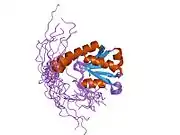| NCOA5 | |||||||||||||||||||||||||||||||||||||||||||||||||||
|---|---|---|---|---|---|---|---|---|---|---|---|---|---|---|---|---|---|---|---|---|---|---|---|---|---|---|---|---|---|---|---|---|---|---|---|---|---|---|---|---|---|---|---|---|---|---|---|---|---|---|---|
 | |||||||||||||||||||||||||||||||||||||||||||||||||||
| |||||||||||||||||||||||||||||||||||||||||||||||||||
| Identifiers | |||||||||||||||||||||||||||||||||||||||||||||||||||
| Aliases | NCOA5, CIA, bA465L10.6, nuclear receptor coactivator 5 | ||||||||||||||||||||||||||||||||||||||||||||||||||
| External IDs | OMIM: 616825 MGI: 2385165 HomoloGene: 32496 GeneCards: NCOA5 | ||||||||||||||||||||||||||||||||||||||||||||||||||
| |||||||||||||||||||||||||||||||||||||||||||||||||||
| |||||||||||||||||||||||||||||||||||||||||||||||||||
| |||||||||||||||||||||||||||||||||||||||||||||||||||
| Wikidata | |||||||||||||||||||||||||||||||||||||||||||||||||||
| |||||||||||||||||||||||||||||||||||||||||||||||||||
Nuclear receptor coactivator 5 (NCOA5), also known as coactivator independent of AF-2 function (CIA), is a protein that in humans is encoded by the NCOA5 gene.[4][5]
Function
This gene encodes a coregulator for the alpha and beta estrogen receptors and the orphan nuclear receptor Rev-ErbA beta. The protein localizes to the nucleus, and is thought to have both coactivator and corepressor functions. Its interaction with nuclear receptors is independent of the AF2 domain on the receptors, which is known to regulate interaction with other coreceptors. Two alternatively spliced transcript variants for this gene have been described. However, the full length nature of one of the variants has not been determined.[4]
References
- 1 2 3 GRCm38: Ensembl release 89: ENSMUSG00000039804 - Ensembl, May 2017
- ↑ "Human PubMed Reference:". National Center for Biotechnology Information, U.S. National Library of Medicine.
- ↑ "Mouse PubMed Reference:". National Center for Biotechnology Information, U.S. National Library of Medicine.
- 1 2 "Entrez Gene: NCOA5 nuclear receptor coactivator 5".
- ↑ Sauvé F, McBroom LD, Gallant J, Moraitis AN, Labrie F, Giguère V (January 2001). "CIA, a Novel Estrogen Receptor Coactivator with a Bifunctional Nuclear Receptor Interacting Determinant". Molecular and Cellular Biology. 21 (1): 343–53. doi:10.1128/MCB.21.1.343-353.2001. PMC 88807. PMID 11113208.
Further reading
- Olsen JV, Blagoev B, Gnad F, et al. (2006). "Global, in vivo, and site-specific phosphorylation dynamics in signaling networks". Cell. 127 (3): 635–48. doi:10.1016/j.cell.2006.09.026. PMID 17081983. S2CID 7827573.
- Tao WA, Wollscheid B, O'Brien R, et al. (2005). "Quantitative phosphoproteome analysis using a dendrimer conjugation chemistry and tandem mass spectrometry". Nat. Methods. 2 (8): 591–8. doi:10.1038/nmeth776. PMID 16094384. S2CID 20475874.
- Brandenberger R, Wei H, Zhang S, et al. (2005). "Transcriptome characterization elucidates signaling networks that control human ES cell growth and differentiation". Nat. Biotechnol. 22 (6): 707–16. doi:10.1038/nbt971. PMID 15146197. S2CID 27764390.
- Jiang C, Ito M, Piening V, et al. (2004). "TIP30 interacts with an estrogen receptor alpha-interacting coactivator CIA and regulates c-myc transcription". J. Biol. Chem. 279 (26): 27781–9. doi:10.1074/jbc.M401809200. PMID 15073177.
- Strausberg RL, Feingold EA, Grouse LH, et al. (2003). "Generation and initial analysis of more than 15,000 full-length human and mouse cDNA sequences". Proc. Natl. Acad. Sci. U.S.A. 99 (26): 16899–903. Bibcode:2002PNAS...9916899M. doi:10.1073/pnas.242603899. PMC 139241. PMID 12477932.
- Deloukas P, Matthews LH, Ashurst J, et al. (2002). "The DNA sequence and comparative analysis of human chromosome 20". Nature. 414 (6866): 865–71. Bibcode:2001Natur.414..865D. doi:10.1038/414865a. PMID 11780052.
- Sauvé F, McBroom LD, Gallant J, et al. (2001). "CIA, a Novel Estrogen Receptor Coactivator with a Bifunctional Nuclear Receptor Interacting Determinant". Mol. Cell. Biol. 21 (1): 343–53. doi:10.1128/MCB.21.1.343-353.2001. PMC 88807. PMID 11113208.
- Nagase T, Kikuno R, Nakayama M, et al. (2001). "Prediction of the coding sequences of unidentified human genes. XVIII. The complete sequences of 100 new cDNA clones from brain which code for large proteins in vitro". DNA Res. 7 (4): 273–81. doi:10.1093/dnares/7.4.271. PMID 10997877.
External links
- NCOA5 protein, human at the U.S. National Library of Medicine Medical Subject Headings (MeSH)
- NURSA C93
This article incorporates text from the United States National Library of Medicine, which is in the public domain.


